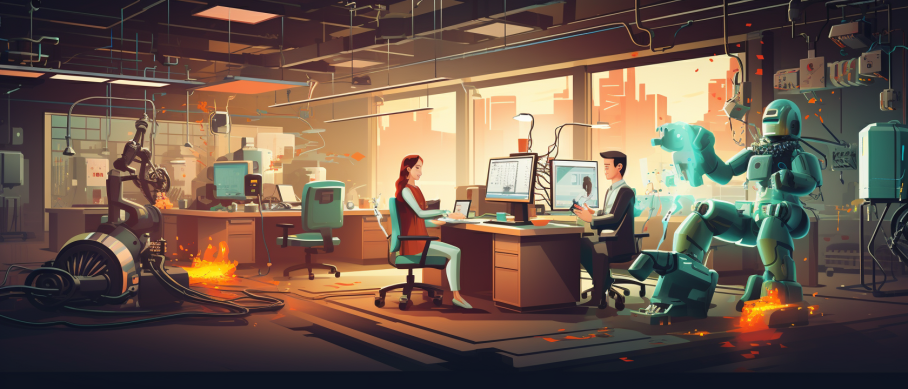Key Takeaways
✅ Risk Assessment and Safety Standards: It's not just about the tech; it's about the people too. Doing your homework by conducting a risk assessment can be a game-changer. Knowing where the pitfalls are, and setting up the guardrails, like ISO 10218, helps keep everything running smooth and everyone out of harm's way.
✅ Human-Robot Interaction (HRI) and Safety Training: Imagine a workplace where robots and humans work in harmony. Turn this into reality with solid safety training, clear rules for robot usage, and nifty safety buttons and sensors. Prevention is better than cure, right?
✅ Regular Maintenance and Monitoring: Robots might not complain when they have a headache, but regular check-ups and tune-ups are key to keeping them in tip-top shape. Keep an eye on your robotic buddies; they're part of the team too!

Introduction
Ever wondered if robots could make your workplace not just more efficient but also safer? Sure, it sounds a bit sci-fi, but it's happening right now all over the world. Robotics is transforming the way we work, but with great power comes great responsibility – the responsibility to keep our human workforce safe. Safety First: Best Practices for Implementing Robotics in the Workplace isn't just a phrase; it's the foundation of introducing new tech into our lives.
But hey, where do you start? What do you need to know? That's exactly what we're here to dive into. We'll explore modern trends, from how the design of a robot can make a huge difference in daily operations, to the ins and outs of Human-Robot Interaction that don't leave room for Ouch moments. Who wouldn't want to be part of a workspace that's not only leading edge but also wrapped up in a safety blanket?
You're right at the threshold of discovering actionable insights and revolutionary methods to boost not just your revenue or ROI but also ensure that your team goes home in one piece every single day. So, are you ready to lead your workplace into a future where robots are your best pals? Stick around; we've got all the intel you need.

Top Statistics
| Statistic | Insight |
|---|---|
| Global Industrial Robotics Market: Projected at $73.1 billion by 2026. (Source: MarketsandMarkets) | With such substantial growth, robotics are transforming the industrial landscape, becoming integral to modern manufacturing. |
| Cobot Market Growth: Expected to soar to $9.4 billion by 2027. (Source: Allied Market Research) | This spike reflects the increasing desire for collaboration between humans and machines on the factory floor. |
| Manufacturing Dominance: Represents 52% of the industrial robotics market. (Source: IFR) | This sector's dominance underscores a shift towards automation to boost productivity and uphold safety standards. |
| Human-Robot Collaboration Market: Expected to grow from $7.4 billion in 2020 to $11.4 billion by 2025. (Source: Research and Markets) | Human-robot collaboration is not just a trend; it's an evolving partnership aiming to enhance safety and efficiency. |
| Advanced Robotics in Manufacturing: By 2025, 30% of manufacturers will employ advanced robotics. (Source: Gartner) | Manufacturers are gearing up for a future where robots tackle complex tasks, revolutionizing safety and capabilities in unpredictable environments. |
Risk Assessment
Ever heard that saying, "look before you leap"? That's pretty much what risk assessment is in the robotics world. Before you set those clever robots loose on your workplace floor, you've got to scope out the scene for any potential troublemakers—risks that could cause damage, injury, or send your productivity into a tailspin. This isn't just a casual once-over; it's about digging deep and asking, "What could possibly go wrong?" And when you find those sneaky hazards lurking in the corners, you craft a smart plan to keep them in check.

Robot Design and Selection
Imagine you're picking out a new pet. Would you go for a fierce guard dog when you live in a tiny apartment with your three cats? Not likely. Same goes for choosing robots. Opt for ones designed with safety as a priority—like robots that know how to stop on a dime if something's in their way (think of collision detection), or ones that have an emergency stop feature, and come with safety certifications that make sure they're the good guys. It's about matching the right robot to your workplace; one that will play nice with your team and not cause any trouble.
Human-Robot Interaction (HRI)
Now, working with robots isn't like working with humans—they don't need coffee breaks, and they're not going to gossip at the water cooler. But you still need rules for the game. Creating guidelines for safe human-robot interaction is key. It's like teaching your employees to speak robot—knowing when to get close, when to step back, and what all those beeps and lights mean. Proper HRI protocols make sure everyone gets along fine and keeps their fingers and toes.
Workplace Layout and Infrastructure
Think of it like setting up a high-tech dance floor—the right workplace layout makes all the difference. It's about giving robots the space to groove without bumping into people or equipment. And let's not forget about the infrastructure—that's all the backstage stuff like power sources and communication systems that need to be safe and solid. If your factory floor were a castle, you'd want a strong fortress with no crumbling walls, right?

Maintenance and Inspection
If you've ever skipped a car service and ended up broken down on the side of the road, you know regular maintenance is non-negotiable. It's no different for robots—they need check-ups, tweaks, and regular maintenance to stay in peak condition. Draft a maintenance schedule and stick to it. Keeping a robotic pentathlon champion running smoothly means no unexpected bench time.
Regulatory Compliance and Standards
Playing by the rules is more than just good manners—it keeps you out of trouble. Staying on top of regulatory compliance and safety standards like those set by OSHA and ISO is like having a rulebook in your back pocket. It keeps you, your team, and your robotic pals in the clear. Plus, if you keep your ear to the ground for updates, you'll never be caught off guard by new rules entering the game.
By honing in on these aspects of robotics safety and making some smart moves, businesses can harness the power of robots while keeping a tight grip on safety. It's all about balance—like a tightrope walker, you need to stay focused and nimble to keep everything running smoothly and safely.

AI Marketing Engineers Recommendation
Recommendation 1: Conduct a Risk Assessment: Begin with a thorough risk assessment specific to your workspace layout and the types of robots you're bringing in. Look into recent data from similar industries to understand common incidents. What does it say about the most frequent accidents? Use this information to prepare your safety measures. This could include clear demarcation of robot-operating zones, protective barriers, or implementing sensors that shut down robots when humans are too close.
Recommendation 2: Invest in Employee Training: Trends are showing us that workplaces equipped with robots require a workforce skilled not just in their usual tasks, but also in interacting safely with robotics. Make it your mission to provide ongoing training programs that keep your team up-to-date on the best practices for working alongside robots. Can they identify the warning signs of a malfunction? Do they know the emergency protocols? This kind of familiarity can drastically reduce workplace accidents.
Recommendation 3: Leverage Smart Safety Technology: It's not enough just to have safety protocols—use smart technology to enforce them. Technologies such as machine vision for detecting the presence of humans and real-time analytics to monitor robot performance are becoming increasingly popular. How could adding these to your workplace improve safety and efficiency? These systems can help prevent accidents by providing real-time alerts and ensuring robots are only active when it's safe. This proactive approach can save money and lives in the long run.

Relevant Links
- Become an Affiliate Marketing Maestro: 2024 Edition
- ChatGPT Unleashed: Free vs. Paid - Make the Right Choice
- Creating Content Like a Pro with ChatGPT
- Unlock the Secrets to Crafting High-Converting Google Ads Text with AI
- Ride the Wave of Top Digital Marketing Trends for 2024
Conclusion
So, what have we really learned about blending the new world of robotics with the old-school values of workplace safety? The key takeaway is simple yet vital: safety must lead the way in the robotic revolution of our work spaces. Walking through risk assessments is like having a safety road map, where potential hazards wave red flags, demanding our full attention before we proceed.
And how about those robots, huh? They need to be designed like the best of allies, equipped with senses that keep us out of harm's way – think collision detection and those big red emergency buttons. After all, what good is a state-of-the-art machine if it doesn't play well with team human? It’s essential to choose robots that not only do the job but also come with a safety seal of approval.
Speaking of humans, we shouldn't forget the importance of setting the stage for a graceful human-robot dance. It’s about choreographing a workplace where everyone – and every 'bot – knows their steps. Safe interaction is the name of the game, and it's one where proper training takes the spotlight. And when we're talking about scenery, the workplace layout matters just as much as a well-designed stage for a ballet. Safety is in the layout details, ensuring that every power outlet and communication system hits the right notes.
Let's not overlook the encores – regular maintenance and inspections keep the robotics show running smoothly, ensuring that each performance is as safe as the first. And in this play, regulations are our script, guiding us through the acts and scenes of robotic implementation. Staying up to date with safety standards isn't just good practice; it's the law of the land.
Wrapping it all up, remember that embracing robotics isn't about speed or rushing into the future without looking; it's about moving forward with a safety compass, ensuring nobody gets lost or hurt along the way. So, what steps will you take to make your workplace not just automated, but also secure, supportive, and safe for every team member? It’s time to think ahead. Let's lead the charge with safety first, making sure that as we welcome robots into our work lives, we're also taking care of each other.

FAQs
Question 1: What are the primary safety concerns when introducing robots into the workplace?
Answer: Primary safety concerns include potential hazards such as mechanical failure, electrical hazards, unintended collisions with humans or other machinery, and environmental factors that could affect robot performance.
Question 2: How can I ensure that my robotics system is safe for workers?
Answer: Implementing a risk assessment process, following industry standards and guidelines, and adhering to safety protocols such as physical barriers, safety sensors, and emergency stop buttons are essential for ensuring worker safety.
Question 3: What are the key industry standards and guidelines for robotics safety?
Answer: Key industry standards and guidelines include ISO 10218 (Robots and robotic devices – Safety requirements for industrial robots), ANSI/RIA R15.06 (Industrial Robots and Robot Systems – Safety Requirements), and OSHA's guidelines for robotics safety.
Question 4: How can I train my employees to work safely with robots?
Answer: Providing comprehensive training on robotics safety, including proper operation, maintenance, and emergency procedures, is crucial for ensuring employee safety. Regular refresher training and clear communication of safety protocols are also essential.
Question 5: What are the best practices for maintaining robotics systems to ensure safety?
Answer: Best practices for maintaining robotics systems include regular inspections, preventive maintenance, proper lubrication, and prompt repair of any malfunctions or defects. Keeping detailed maintenance records and adhering to manufacturer recommendations are also essential.
Question 6: How can I integrate robots into my existing workplace without compromising safety?
Answer: Integrating robots into an existing workplace requires careful planning, including risk assessments, designing safe work cells, and implementing safety protocols. Consulting with experts and engaging employees in the process can help ensure a smooth and safe integration.
Question 7: What are the advanced safety features available for robotics systems?
Answer: Advanced safety features include collaborative robots (cobots) designed to work alongside humans, force sensing and torque limiting capabilities, advanced safety sensors, and machine learning algorithms that can detect and respond to potential safety hazards.
Question 8: How can I ensure that my robotics system is compliant with relevant safety regulations?
Answer: Ensuring compliance with relevant safety regulations requires staying up-to-date with industry standards and guidelines, conducting regular risk assessments, and working with experts to ensure that your robotics system meets all necessary requirements.
Question 9: What are the most common mistakes to avoid when implementing robotics in the workplace?
Answer: Common mistakes to avoid include failing to conduct a thorough risk assessment, neglecting employee training, ignoring maintenance requirements, and not adhering to industry standards and guidelines.
Question 10: What are the key benefits of prioritizing safety when implementing robotics in the workplace?
Answer: Prioritizing safety when implementing robotics in the workplace can help reduce the risk of accidents, improve employee morale, increase productivity, and enhance the overall reputation of your organization.

Academic References
- Haddadin, K., Croft, E., Albu-Schäffer, A., & De Luca, A. (2017). Human-Robot Interaction in Manufacturing: Safety and Acceptance. International Journal of Advanced Robotic Systems, 14(1). This in-depth article shines a light on the essential safety standards and human-robot collaboration in manufacturing scenarios. It underscores the necessity of conducting risk assessments, providing adequate training, and maintaining open communication channels to safeguard a harmonious integration of robotics within the work sphere.
- Ahmad, A., Paul, P., & Rathore, A. P. S. (2019). Robotics in the Workplace: A Review of Safety Standards and Best Practices. Safety Science, 111. This comprehensive review meticulously outlines the prevailing safety standards and best practices for deploying robotics in work settings. It stresses the significance of conducting risk evaluations, establishing safety zones, and utilizing sensors alongside safety-rated control systems, thereby mitigating the probability of mishaps and ensuring the well-being of personnel.
- Al-Yacoub, A., Schlick, C. M., & Duckworth, T. (2017). Human-Robot Interaction in Industrial Environments: A Review of Existing Research and Guidelines for Implementation. International Journal of Advanced Robotic Systems, 14(1). This scholarly piece examines the body of research on human-robot interaction within industrial settings and extends practical guidelines for the utilization of robotics in these environments. Considerations such as ergonomics, human-centric design, and proficiency development are discussed to facilitate an integration that is both safe and productive.
- Paganelli, M., Ippolito, A. P., & Orso, V. (2019). Safety in Human-Robot Interaction: A Review of Technological and Organizational Aspects. Safety Science, 111. Delving into both the technological and organizational facets of safety in human-robot interactions, this article addresses the pivotal role of risk evaluations, safety-rated control systems, and organizational strategies such as training and effective communication in realizing the seamless amalgamation of robotics into workplace paradigms.
- Ahmad, A., & Natraj, A. (2018). Safety and Security of Industrial Robots: A Survey. IEEE Transactions on Industrial Electronics, 65(12). Offering an extensive survey on the safety and security concerns affiliated with industrial robots, this article discusses the imperative nature of risk assessments, adherence to safety protocols, and the implementation of security strategies as a buffer against both physical and cyber threats, thus reinforcing the sanctity of the industrial terrain.






